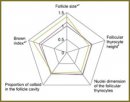
Alterations of Thyroid Morphology and Function After Long-Term Exposure to Low Doses of Endocrine Disruptor Dichlorodiphenyltrichloroethane
The aim of the investigation was to evaluate changes in thyroid morphology and function after different long-term exposure to low doses of endocrine disruptor dichlorodiphenyltrichloroethane (DDT) under the maximum permissible levels in food products.
Materials and Methods. The experiment was performed on adult male Wistar rats (n=62). Drinking water was substituted for water solution of o,p-DDT 20 and 80 μg/L. Mean daily consumption of DDT was 1.89±0.86 and 7.77±0.17 µg/kg body weight, respectively. Rat serum thyroid hormone content and histology of the thyroid glands were studied after 6 and 10 weeks of exposure to DDT.
Results. 6-week exposure to DDT caused inhibition of thyroid function followed by reactive increase of thyroid stimulating hormone secretion and triiodothyronine production. These symptoms were similar to those of the early stage of iodine deficiency. Restoration of rat thyroid status after 10 weeks of exposure was achieved due to diffuse microfollicular transformation of thyroid parenchyma.
Conclusion. Exposure to low doses of DDT inhibits thyroid function. Reactive increase of thyroid hormone production after exposure to DDT and in iodine deficiency is similar, but early changes in thyroid histology are different. Long-term exposure to DDT is supposed to aggravate iodine deficiency and to be a risk factor of thyroid tumors.
- Diamanti-Kandarakis E., Bourguignon J.-P., Guidice L.C., Hauser R., Prins G.S., Soto A.M., et al. Endocrine-disrupting chemicals: an Endocrine Society scientific statement. Endocr Rev 2009 Jun; 30(4): 293–342, http://dx.doi.org/10.1210/er.2009-0002.
- Yaglova N.V., Yaglov V.V. Endocrine disruptors are a novel direction of endocrinologic scientific investigation. Vestnik RAMN 2012; 3: 56–61.
- National Toxicology Program’s report of the endocrine disruptors low dose peer review. National Institute of Environmental Health Sciences, NIH National Toxicology Program. 2001.
- Vandenberg L.N., Colborn T., Hayes T.B., Heindel J.J., Jacobs D.R. Jr., Lee D.-H., Shioda T., Soto A.M., vom Saal F.S., Welshons W.V., Zoeller R.T., Myers J.P. Hormones and endocrine-disrupting chemicals: low-dose effects and nonmonotonic dose responses. Endocr Rev 2012; 33(3): 378–455, http://dx.doi.org/10.1210/er.2011-1050.
- Gigienicheskie trebovaniya bezopasnosti i pishchevoy tsennosti pishchevykh produktov. SanPin 2.3.2.1078-01 [Hygienic requirements to safety and nutritional value of food products. Sanitary rules and norms 2.3.2.1078-01]. 2008.
- Yaglova N.V. Impairments of the secretory cycle of follicular thyrocytes and their correction by thyroid-stimulating hormone in experimental syndrome of nonthyroid diseases. Bulleten’ eksperimental’noj biologii i mediciny 2011; 152(8): 215–219.
- Orton F., Rosivatz E., Scholze V., Kortenramp A. Widely used pesticides with previously unknown endocrine activity revealed as in vitro antiandrogenes. Environ Health Perspect 2011; 119(6): 794–800, http://dx.doi.org/10.1289/ehp.1002895.
- Lacroix M., Hontela A. The organochlorine o,p’-DDT disrupts the adrenal steroidogenic signaling pathway in rainbow trout (Oncorhynchus mykiss). Toxicol Appl Pharmacol 2003; 190(3): 197–205, http://dx.doi.org/10.1016/S0041-008X(03)00168-6.
- Scollon E., Carr J., Cobb C. The effect of flight. Fasting and p,p’-DDT on thyroid hormones and corticosterone in Gambel’s white-crowned sparrow, Zonotrichia leocophrys gambelli. Comp Biochem Physiol C Toxicol Pharmacol 2004; 137(2): 179–189.
- Schell L.M., Gallo M.V., Denham M., Ravenscroft J., DeCaproi A.P., Carpenter D.O. Relationship of thyroid hormone levels to levels of polychlorinated biphenyls, lead, p,p’-DDE, and others toxicants in Akwesasne Mohawk youth. Environ Health Perspect 2008; 116(6): 806–813, http://dx.doi.org/10.1289/ehp.10490.
- Langer P. The impacts of organochlorines and other persistent on thyroid and metabolic health. Front Neuroendocrinol 2010; 31(4): 497–518, http://dx.doi.org/10.1016/j.yfrne.2010.08.001.
- Meeker J., Altshul L., Hauser R., Serum PCBs, p,p’-DDE and HCB predict thyroid hormone levels in men. Environ Res 2007; 104(2): 296–304, http://dx.doi.org/10.1016/j.envres.2006.11.007.
- Denef J.-F., Haumont S., Beckers C. Morphological changes in mice thyroid induced by iodine deficiency. Virchows Arch B Cell Path 1980; 32: 191–199.
- Khmel'nitskiy O.K. Tsitologicheskaya i gistologicheskaya diagnostika zabolevaniy shchitovidnoy zhelezy [Cytologic and histologic diagnosis of thyroid gland diseases]. Saint Petersburg: SOTIS; 2002; 288 p.










